Traditionally, the session ‘Advanced Composites and Applications’ will be organized by the Institute for Mechanics of Materials of the University of Latvia (LU MMI) on 13.02.2024 as a part of the annual 82nd scientific conference of the University of Latvia. It will be organized remotely in Zoom. The official language of the section is English. The duration of the presentation should be 10 minutes.
The section will be devoted to the discussion of the recent results within the following topics:
-structure and properties of polymers and polymer-based composites;
-long-term properties, creep, and environmental ageing;
-composites for advanced applications;
-mechanical aspects of technology;
-multifunctional properties.
Please follow the guidelines provided in the template for the abstract (see below). The abstract should be sent to tatjana.glaskova-kuzmina@lu.lv by February 1.
The link to the Zoom meeting:
https://lu-lv.zoom.us/j/91554244480?pwd=NTR1YjJ6WkhnbWxOTysycXpMMGdIUT09
Meeting ID: 915 5424 4480
Passcode: 417429
Programme
Chair: Assist. Prof. Tatjana Glaskova-Kuzmina | ||
10:00-10:05 | Tatjana Glaskova-Kuzmina University of Latvia, Riga, Latvia | Opening of the Conference session |
10:05–10:20 | Andrejs Krauklis and Sotirios Grammatikos Norwegian University of Science and Technology, Gjøvik, Norway | Modular framework for modelling composite material-environment interactions |
10:20–10:35 | Anish Niranjan Kulkarni, Andrejs Pupurs, Olga Kononova, and Vladislavs Jevstigņejevs Riga Technical University, Riga, Latvia | Micro-damage evolution in novel composite-metal joints with textile mesostructure |
10:35–10:50 | Mostafa Sadeghian and Naginevičius Vytenis Kaunas University of Technology, Kaunas University of Applied Engineering Sciences, Kaunas, Lithuania | Static higher-order analysis of nanoplates using an analytical approach |
10:50–11:05 | Leons Stankevics, Jevgenijs Sevcenko, and Andrey Aniskevich University of Latvia, Riga, Latvia | Modelling of linear viscoelastic creep of 3D printed PETG samples |
11:05-11:20 | Mughees Shahid and Daiva Zelenkiene Kaunas University of Technology, Kaunas, Lithuania | Numerical investigation of different natural, synthetic or hybrid fiber-reinforced polymer composites for automotive applications |
11:20-11:35 | Sultan Ullah, Muhhamad Faizan Ali, Hassan Iftikhar, and Giedrius Janusas Kaunas University of Technology, Kaunas, Lithuania National Textile University, Faisalabad, Pakistan | Dibutyle phthalate (DBP) infusion: crafting mechanical excellence in polyester matrix composites |
11:35-11:50 | Gabriele Jovarauskaite, Gediminas Monastyreckis, and Daiva Zeleniakiene Kaunas University of Technology, Kaunas, Lithuania | Self-sensing sandwich composites with electrically conductive MXene nanoparticles |
11:50-12:20 | Coffee break | |
12:20-12:35 | Gytautas Rinkevicius and Daiva Zeleniakiene Kaunas University of Technology, Kaunas, Lithuania | Smart de-icing system for structural composites |
12:35-12:50 | Gopi Kompelli, Arunas Kleiva, and Rolanas Dauksevicius Kaunas University of Technology, Kaunas, Lithuania | 3D printable lead-free piezoelectric polymer-ceramic composites manufactured using more environmentally responsible melt-based process |
12:50–13:05 | Monika Chomiak, Małgorzata Szymiczek, Iwona Gródek and Wojciech Danek Silesian University of Technology, Gliwice, Poland Symkom Sp. z o. o., Warsaw, Poland | Analysis of the progress of processing shrinkage of injection molded parts using the optical method |
13:05-13:20 | Angelika Jasinska and Piotr Zagulski Kielce University of Technology, Kielce, Poland | Influence of curing and post-curing processes on the service life of polymer matrix composite materials |
13:20-13:35 | Tatjana Glaskova-Kuzmina, Didzis Dejus, Jānis Jātnieks, Elīna Vīndedze, Irina Bute, Jevgenijs Sevcenko, Andrey Aniskevich, and Stanislav Stankevich Baltic3D.eu, Riga, Latvia, University of Latvia, Riga, Latvia | Evaluation of tensile, thermal and flame-retardant properties of 3D printed parts of polyetherimide and polyetherketoneketone |
13:35-13:50 | Concluding remarks | |

